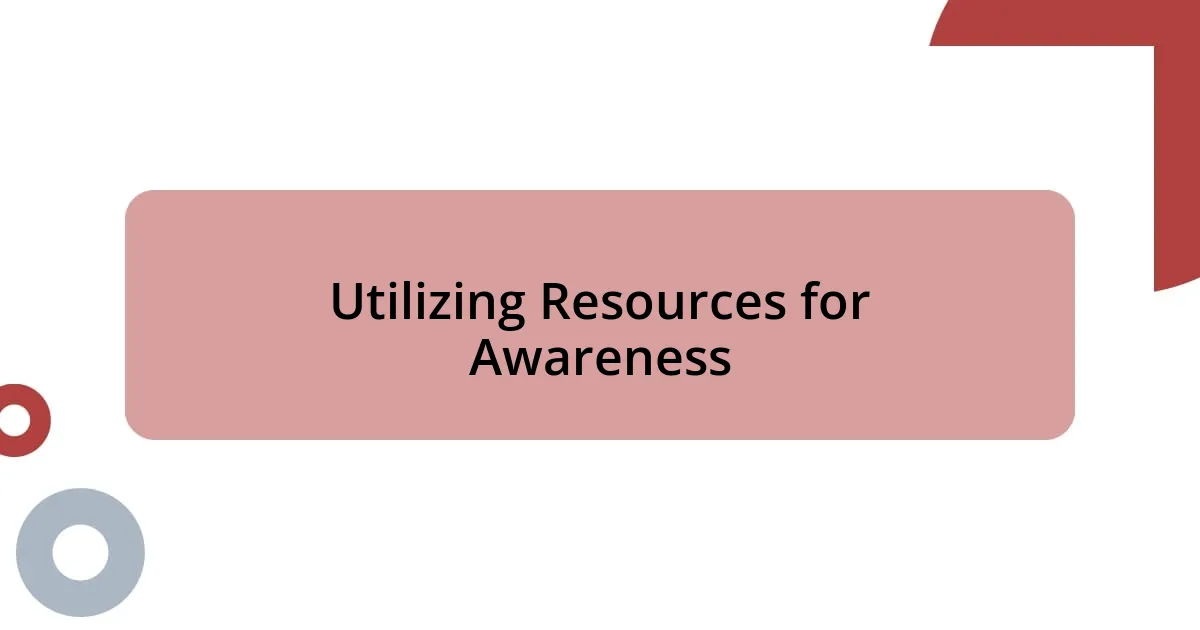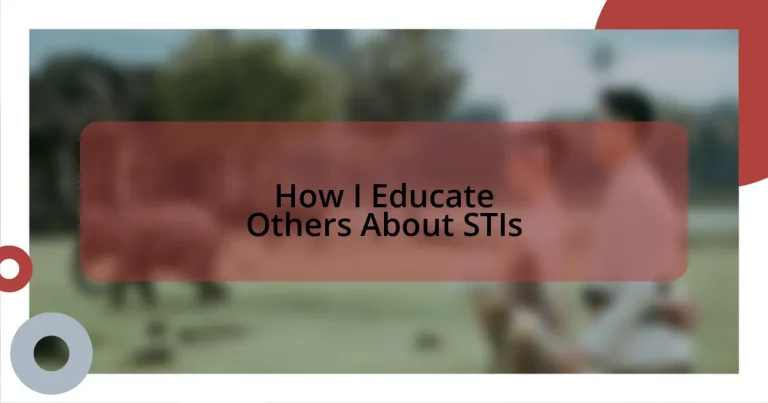Key takeaways:
- STIs can affect anyone, emphasizing the need for regular testing and awareness of emotional impacts, stigma, and reproductive health consequences.
- Education about STIs should involve open dialogue, relatable experiences, and the use of engaging materials like brochures and multimedia to foster understanding.
- Utilizing community resources and creating a supportive environment encourages individuals to seek knowledge and feel empowered in managing their sexual health.
- Collecting and adapting to participant feedback enhances the effectiveness of educational efforts, ensuring they resonate with diverse audiences.

Understanding STIs and Their Impact
Understanding STIs starts with recognizing their prevalence and the varied ways they can affect lives. I remember a close friend who, despite being careful, discovered she had an STI during a routine check-up. It shocked her, and it brought home the reality that anyone can be at risk, regardless of how responsible they believe they are.
The emotional toll of an STI diagnosis can’t be understated. I once attended a support group where people shared their stories, and it became clear how stigma can exacerbate feelings of shame and isolation. Have you ever considered how the fear of judgment might keep someone from seeking treatment? That fear can delay important medical attention, leading to more serious health complications.
It’s also crucial to understand that STIs can have significant implications for reproductive health. Some STIs, if left untreated, can lead to infertility or chronic pain. Speaking from experience, I’ve seen how knowledge about these potential impacts can empower individuals to take proactive steps in their sexual health journey. Wouldn’t it be better if everyone felt informed and equipped to make safe choices?

Identifying Common Types of STIs
Identifying common types of STIs is essential for empowering individuals to recognize their risks. From my perspective, two of the most prevalent STIs are chlamydia and gonorrhea. I recall a health workshop where participants were surprised to learn that these infections can often show no symptoms, making regular testing vital for sexual health.
In terms of viral infections, human papillomavirus (HPV) and herpes simplex virus (HSV) have become really significant. I once met someone who thought they were safe because they had no symptoms, but they later discovered they were carrying HPV. This experience highlighted how crucial it is to educate others about asymptomatic infections and the importance of vaccines, like the HPV vaccine, which can significantly reduce the risk of cervical cancer.
Here’s a comparison table outlining some common STIs:
| Type of STI | Common Symptoms |
|---|---|
| Chlamydia | Often asymptomatic; may include discharge and pain during urination |
| Gonorrhea | May cause discharge and painful urination; often asymptomatic in women |
| HPV | Usually asymptomatic; may cause genital warts and leads to various cancers |
| Herpes | Painful blisters or sores; can be asymptomatic |

Ways to Effectively Educate Others
Effective education about STIs hinges on open dialogue and creating a safe space for discussion. I remember hosting a small gathering with friends, where we casually chatted about sexual health. The atmosphere felt relaxed, and it sparked honest conversations about misconceptions surrounding STIs. These informal settings can often lead to deeper understanding, as participants feel less judged and more willing to share their thoughts.
To facilitate engaging conversations, consider these strategies:
- Start by sharing relatable stories or experiences to break the ice.
- Use humor where appropriate to lighten the mood, making the topic less intimidating.
- Encourage questions and validate concerns, showing that seeking knowledge is both brave and necessary.
- Offer resources, such as brochures or websites, that provide accurate information for further learning.
- Suggest attending community health events together, making the journey of learning a shared experience.
By fostering an environment of trust, I’ve seen firsthand how people can overcome their fears and misconceptions about STIs, leading to more informed and healthier choices.

Practical Approaches for Discussions
When discussing STIs, I find that using relatable scenarios can really resonate with people. I once shared a personal story about a close friend who encountered stigma after a diagnosis. By highlighting their fears and triumphs, I noticed that others began to open up about their own experiences and uncertainties. Isn’t it interesting how vulnerability can spark genuine dialogue?
It’s essential to create an inviting atmosphere during these discussions. I recall a community health fair where I set up a booth. The friendly vibe made it easier for attendees to approach me with their questions. They appreciated that I wasn’t an expert preaching at them; instead, I was just someone willing to chat and share insights. I believe that when people feel comfortable, they will engage more openly, turning a potentially awkward conversation into meaningful learning experiences.
Incorporating visual aids can also enhance understanding. I remember using brochures and interactive quizzes to illustrate STI transmission and prevention methods during a workshop. Watching people engage with the materials was rewarding; they began discussing strategies they hadn’t considered before, such as getting tested regularly and advocating for healthy sexual practices. It made me realize that education isn’t just about sharing facts—it’s about fostering a shared journey toward empowerment.

Utilizing Resources for Awareness
Utilizing various resources is crucial for raising awareness about STIs. I’ll never forget attending a local health workshop where experts shared materials that clarified many misconceptions. Those pamphlets weren’t just informative; they ignited conversations among attendees about their fears and questions. Have you ever seen how a simple brochure can turn an awkward silence into a lively discussion?
In my experience, online platforms can also serve as powerful tools for education. I remember stumbling upon an interactive website that allowed users to explore STI facts through quizzes. It was fascinating to see how many friends got engaged with it. They started sharing their scores and discussing the content, which effortlessly transformed our group chat into an informative exchange. The fun of competing and learning simultaneously can motivate people to seek knowledge actively.
Moreover, community resources, like clinics and support groups, can significantly influence awareness. I once participated in a peer education program at a local clinic, where I helped facilitate discussions among young people. Seeing their eyes widen in surprise at the information shared made it clear how much they valued the experience. It felt empowering to witness them connect the dots and recognize the importance of STI education as part of their health journey. Isn’t it incredible how education, when done right, fosters both knowledge and community support?

Creating Educational Materials and Workshops
Creating educational materials and workshops focused on STIs is something I deeply believe in, as they can make a world of difference. Reflecting on my first workshop experience, I designed handouts that were colorful and engaging, incorporating infographics that simplified complex information. I felt a sense of fulfillment when participants expressed how much clearer their understanding became just from glancing at these visuals. Why shouldn’t education be both informative and visually appealing?
During a recent workshop, I introduced role-playing scenarios to help participants engage actively with the material. Watching them step into different roles and navigate conversations about STIs was both amusing and enlightening. I recall one participant, who was initially shy, confidently role-playing a supportive friend discussing test results. This moment made me realize the power of experiential learning—it allows people not only to learn but to practice empathy and understanding in a safe environment.
Additionally, I’ve found that incorporating multimedia elements, such as videos or animations, significantly enhances learning. In one session, I used a short animated film to illustrate common myths about STIs. The room was filled with laughter and surprise as people recognized misconceptions they had previously held. Isn’t it remarkable how humor can break down barriers and encourage open conversations? It made the discussion feel less daunting, fostering a collaborative atmosphere where everyone felt safe to express their views and ask questions.

Evaluating Impact and Feedback
Evaluating the impact of my STI education efforts has been a rewarding journey. After each workshop, I ask participants to share their feedback, and honestly, their responses often surprise me. I vividly remember one attendee telling me that they finally understood how to approach conversations about STIs with their partner. Isn’t it thrilling to hear firsthand how the knowledge I spread could change someone’s relationship dynamics?
Collecting feedback is not just about quantitative data; it’s also about the qualitative stories that emerge. For instance, I once conducted a follow-up survey a couple of months after a workshop. One participant shared how they used the information to inform a friend who was hesitant about getting tested. That moment really hit home for me. It’s moments like these that emphasize how education ripples out, impacting not just individuals, but their communities as well.
Additionally, I’ve learned to adapt my approach based on this feedback over time. When participants mentioned feeling overwhelmed by the terminology, I adjusted my materials to simplify language while still delivering vital information. This was an eye-opener—I realized that creating a welcoming learning environment means being receptive to others’ needs and adjusting accordingly. How can we ensure our educational efforts truly resonate if we don’t listen to our audience? In my experience, this is a continual learning process that enriches both my teaching and their comprehension.














